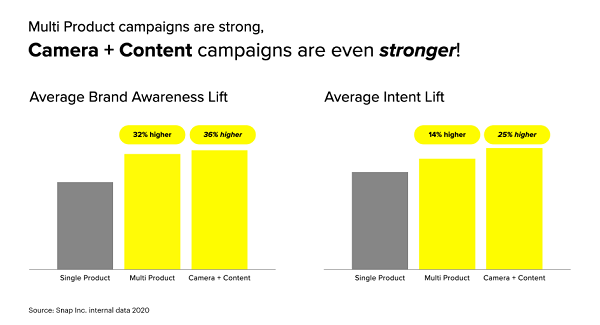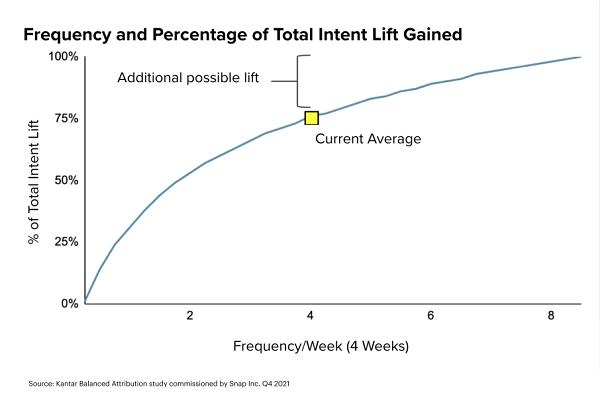What’s the best way to maximize your campaign performance on Snapchat AR?
Snap has sought to provide some more insight on this, via two new studies which look at the ways in which different Snap ad formats drive user response in the app, and how Snapchat’s more advanced AR tools can help to boost brand lift and awareness.
The first study, conducted in partnership with Kantar, analyzed 52 Snapchat ad campaigns, among 50,000 respondents, to get a better gauge on what’s working right now.
The key finding? Utilizing multiple ad formats within your campaign drives significantly better results.

As you can see in this chart, the data shows that utilizing multiple Snap ad formats within your campaigns drives better results in both brand awareness and intent, while utilizing the Snap Camera amplifies this even further.
As per Snap:
“As target audiences become saturated with Content Ads, which includes Commercials, Snap Ads, and Story Ads, at higher levels, the reallocation of budget towards Camera Ads helps with incremental reach, as well as building differentiated frequency.”
Which aligns with evolving interest in AR more broadly, and advanced connection elements. Snapchat offers a range of ways to build AR-enabled campaigns, and these results show that adding interactive features can provide a big kick in your performance.
The research also shows that marketers are able to increase their ad exposure within the app to improve performance, as opposed to oversaturating their target market:
“On average, across the studies included in this campaign, we found that a frequency of 4x/week drove about three-quarters of total possible Intent lift, with the model predicting total saturation at 8x/week.”

So multiple formats, at higher frequencies, can drive better response to your Snap campaigns. Some key considerations for your approach.
In the second study, in partnership with MAGNA Media Trials, Snapchat put specific focus on AR elements, and how the increased engagement of AR tools can further boost your brand messaging.
The results show that Snap users find AR ads to be significantly more informative than pre-roll ads, while AR ads also help consumers feel closer to the brand.
Snap also notes that different AR formats have different response considerations:
“World Facing AR Lenses impact those in the middle of the journey, and result in higher purchase intent (+8%) and build relevance for the brand (+7%). Front-Facing AR Lenses help lift brand image for those closer to purchase, with a +5% lift in brand uniqueness and 4% lift in relevancy.”
So it’s not just using AR that’s important, but the different kinds of AR tools on offer can also drive variable results, based on this data at least.
Of course, that largely comes down to exactly what your AR experience is, and how it engages uses, so it’s hard to say that front or rear-facing experiences are definitively going to perform better in this context. But in general, based on this research, there is a variance here, which could be another consideration for your approach.
These are some interesting findings and elements to factor in, and if you’re looking for ways to connect with the Snap audience, it’s worth considering the data notes here within your strategy.
There’s a range of additional notes in pointers in Snap’s full study overviews, which you can check out here and here.



